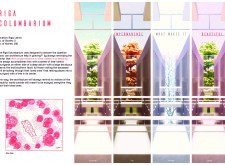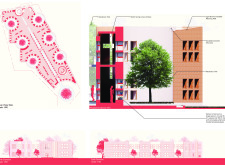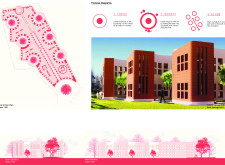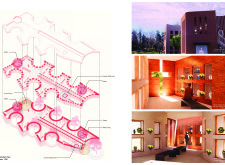5 key facts about this project
At its core, the Riga Columbarium functions as a space that allows visitors to connect with their memories and honor those they have lost. With a total of 490 niches designed to hold individual urns, the columbarium provides a personal space for commemoration. Each niche measures approximately 85 cm square and 100 cm tall, allowing family members to personalize and decorate each space, thereby enhancing the intimate experience of remembrance.
The architectural design emphasizes the importance of nature in the grieving process. Central to the design are two tree-centric courtyards that feature a prominent deciduous tree at the southern end. This tree not only serves as a focal point but also symbolizes the continuity of life, reinforcing the cyclical nature of existence. The courtyards are designed to create a tranquil atmosphere, inviting visitors to engage in contemplation and reflection amidst lush greenery. Visitors are encouraged to gaze into these courtyards, fostering an environment that cultivates serene connection to nature.
The building's architectural structure is grounded in its use of materials. The light brown insulated masonry walls provide both durability and thermal efficiency, contributing to a sense of warmth that is welcoming to all who enter. An insulated concrete structure supports the building's integrity while ensuring energy efficiency, aligning with contemporary sustainable design practices. Together, these materials create a cohesive and functional environment that respects the solemn purpose of the columbarium.
In terms of layout, the design incorporates a deep atrium that allows natural light to flood the interior, enhancing the overall atmosphere and linking indoor spaces with the outside world. This connection to nature is further emphasized by the visual representation of seasonal change embodied by the deciduous tree, which reflects the dynamic nature of life and encourages meaningful reminiscence throughout the year.
The architectural plans and sections provide insight into the thoughtful organization of spaces and the interaction between visitors and their environment. The courtyards, niches, and atrium are arranged in a manner that guides visitors through the columbarium, creating a narrative journey that respects the profound experiences of grief and memory. Each aspect of the design has been meticulously crafted to ensure a seamless flow as one navigates through the space, allowing for moments of both solitude and reflection.
The unique design approaches adopted in the Riga Columbarium differentiate it from traditional memorial spaces. The integration of natural elements within the architecture offers a comforting backdrop for mourning and remembrance, moving beyond the often cold and impersonal characteristics of standard columbariums. Instead, it fosters a tranquil setting that encourages connection and reflection, thereby enhancing the overall experience for visitors.
As you consider the nuances of this architectural project, exploring the architectural designs, plans, and sections will provide an even deeper understanding of the Riga Columbarium's thoughtful integration of nature, memory, and space. By examining the various elements of the design, you can appreciate how this project reshapes the conversation around spaces for remembrance and the role that architecture can play in facilitating emotional engagement.


























